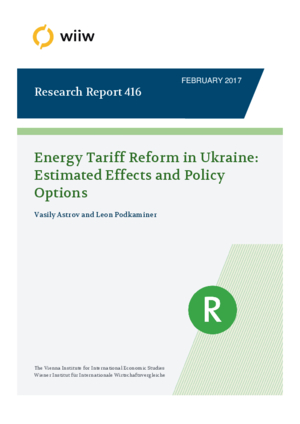Energy Tariff Reform in Ukraine: Estimated Effects and Policy Options
Vasily Astrov and Leon Podkaminer
wiiw Research Report No. 416, February 2017
35 pages including 11 Tables and 7 Figures
Energy sector reforms have for a long time been viewed as one of the most important challenges facing Ukraine. The most visible manifestation of reforms so far has been the steep hikes in energy tariffs for households to ‘market’ levels, above all for natural gas and central heating. The magnitude of gas tariff hikes in Ukraine and the short time span over which they have been implemented have been unprecedented: they rose nearly ten times within less than two and a half years. Partly due to this, between 2013 and 2015 residential gas consumption in Ukraine declined by about one third and will probably fall by another 9% in 2016 according to our estimations, essentially meaning sacrifice of households’ living standards. Because of the higher energy payments, private consumption of other (non-energy) items has suffered as well. This is a disturbing development: the suppressed demand for non-energy consumer goods represents a clear social loss in an economy which has been suffering from a persistent inadequacy of aggregate demand.
At the same time, our analysis demonstrates that the magnitude of gas tariff hikes implemented in Ukraine has been clearly excessive when viewed from the production (cost) side. Under plausible assumptions regarding the dynamics of domestic gas production, residential consumption and gas import prices in the years to come, we come to the conclusion that the state-owned gas monopolist Naftogaz (and, via higher tax revenues, the government at large) will be accruing rents to the tune of at least 2% of GDP – essentially at the expense of the population. The source of this rent is the fact that the wholesale price for largely domestically produced gas has been set now on par with imported gas, which – after the recent sharp reduction in gas demand – is now needed only in limited quantities to cover the households’ needs. To amend the situation in the short run, the government should either extend the scope of energy subsidies to poor households or, even better, roll back the energy tariffs. The latter task should be relatively easy to accomplish as long as Naftogaz remains state-owned.
In the longer run, various measures may be contemplated to improve energy efficiency in the household sector. In this vein, the government may consider extending the scope of subsidies, e.g. by providing lower interest rates and a higher reimbursement rate for energy-efficient loans, especially for the purpose of installation of heating meters in residential buildings. Government subsidies along these lines would be crucial in solving the long-term structural problem of excessive energy consumption, and should enjoy priority over the short-term task of fiscal consolidation.
Keywords: energy demand, energy prices, Almost Ideal Demand System (AIDS)
JEL classification: D12, Q4
Countries covered: Ukraine
Research Areas: Sectoral studies
